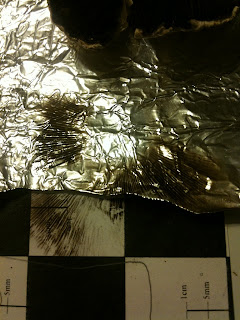Monday, June 20, 2011
Spore print technique
I recently invested in one of Taylor Lockwood's DVDs on mushroom identification. One reason was to address the lack of nature documentaries on fungi being used in the class I taught last term. In the video, he suggests collecting spore prints in a different way. Instead of using contrasting black and white pattern (as I have done), he suggests using aluminum foil. I tried it out with these two sporocarps I collected yesterday, and both great to me, though the spore print on this mushroom is pretty unambiguously dark brown. I can see a couple of advantages to the aluminum foil technique. For one, the spores don't adhere to the paper fibers, meaning it's easier to scrape the surface to make a slide of spores. I can see where it may be helpful in determining spore color in some ambiguous cases as well, and it would be easier to mold a piece of aluminum foil around a mushroom in the field than a piece of paper. Both formats are easily recycled, so it's a draw on that point.
In other news, I found a nice fairy ring on campus that sprang up after the rainstorms we've had recently. We've been in severe water deficit here, and need the rain very badly. So it was nice to see that it was at least enough for this group of mushrooms. I collected a couple, just to test the foil method, and to see if they were not Chlorophyllum molybdites, which is what I've seen most frequently around here in fairy rings. You can see from the photo above that the spore print is most definitely not green but chocolate brown. Thus, those are more likely a species of Agaricus (which one? I need to delve a bit deeper!)
Subscribe to:
Post Comments (Atom)


No comments:
Post a Comment